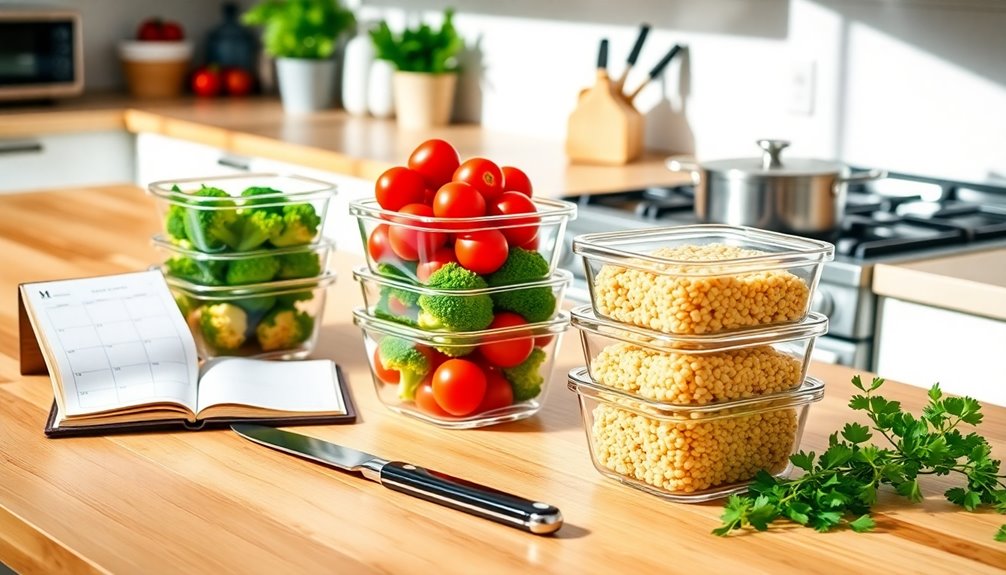To build a consistent meal prep routine, start by evaluating your schedule to find time for cooking. Set clear, achievable goals that keep you motivated. Choose a variety of simple, budget-friendly recipes to keep meals interesting. Create a detailed shopping list organized by category to streamline errands. Invest in essential meal prep tools to enhance efficiency. Designate a specific day for prepping to make it a habit. Organize your ingredients before you start, and use proper storage techniques to maintain freshness. Regularly review your goals and adjust as needed to improve your routine—there's plenty more you can discover to elevate your meal prep game.
Key Takeaways
- Assess your weekly schedule and commitments to identify optimal meal prep days and times for consistency.
- Set SMART goals for your meal prep routine, focusing on specific, measurable, achievable, relevant, and time-bound objectives.
- Choose a variety of time-efficient and budget-friendly recipes, incorporating Keto options for added diversity.
- Invest in essential meal prep tools and organize ingredients for efficient cooking and storage to save time.
- Regularly track your progress, adjust your routine as needed, and celebrate your achievements to stay motivated.
Assess Your Schedule
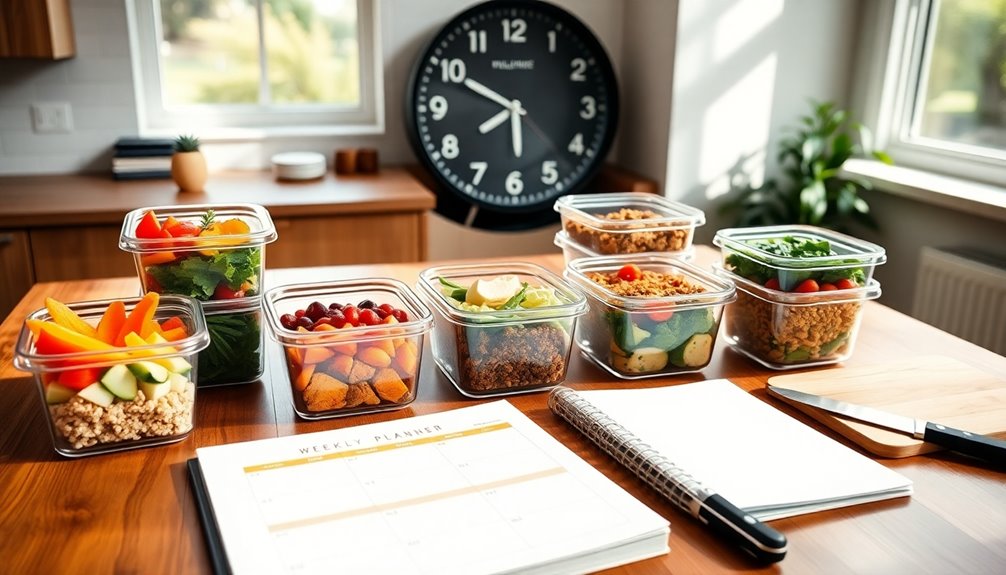
To build a successful meal prep routine, you first need to assess your schedule. Take a close look at your weekly commitments, from work hours to family activities. This step is pivotal because effective time management lays the foundation for a consistent meal prep strategy. Identify the days and times when you can dedicate at least a couple of hours to preparing meals.
Once you've pinpointed those blocks of time, planning ahead becomes essential. Consider planning your meals for the week on a specific day, like Sunday. This not only allows you to use your time wisely but also helps you avoid the last-minute scramble that often leads to unhealthy food choices. Including whole-food protein in your meal prep can enhance your nutritional intake and support your health goals.
Create a simple meal plan that aligns with your schedule, taking into account your nutritional needs and preferences.
Don't forget to factor in grocery shopping. If you know you'll be busy later in the week, try to shop in advance. Make a shopping list based on your meal plan to streamline this process and reduce the chances of impulse buys. Remember, effective meal prep isn't just about cooking; it's about creating a system that fits seamlessly into your life.
Set Clear Goals
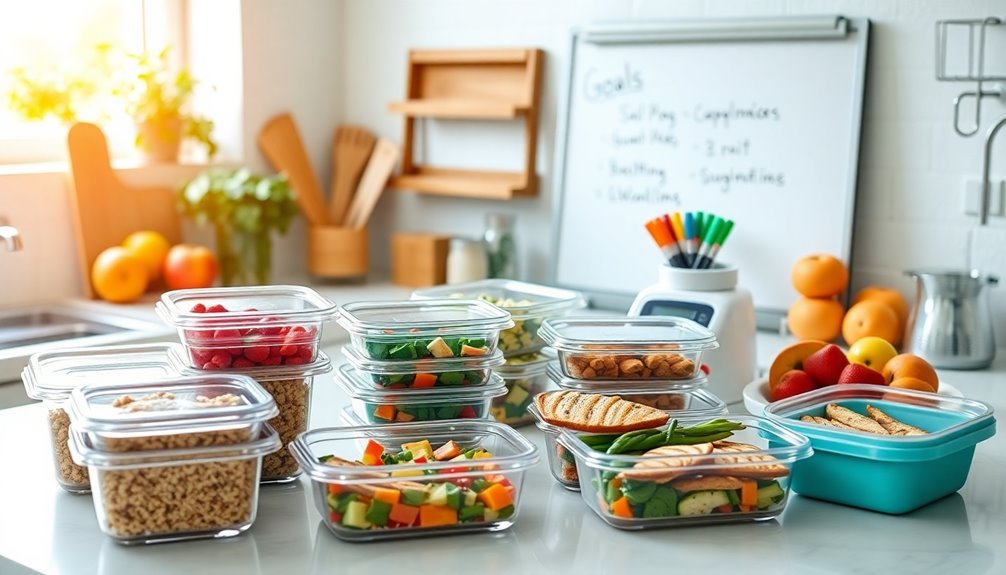
Setting clear goals is essential for establishing a successful meal prep routine, especially since it provides you with direction and motivation. When you define what you want to achieve, whether it's eating healthier, saving time, or sticking to a budget, you create a roadmap for your meal prep journey.
Start with specific, measurable, achievable, relevant, and time-bound (SMART) goals. For instance, instead of saying, "I want to eat better," you could set a goal like, "I'll prep three healthy lunches each week." This clarity helps in tracking progress, making adjustments as needed, and celebrating your achievements along the way.
Goal setting isn't just about the end result; it's about building habits. Break your larger goals into smaller, manageable steps. If your aim is to prep meals every week, begin by setting aside just one day for meal preparation. Gradually, you can increase this as you become more comfortable with the routine. Additionally, consider incorporating Keto recipes into your meal prep as they provide delicious, low-carb options that align with your health goals.
Choose Your Recipes

With clear goals in place, it's time to choose your recipes. Start by examining recipe variety to keep your meals exciting and enjoyable. Aim for a mix of proteins, grains, and vegetables to maintain nutritional balance. This not only helps you meet your dietary needs but also prevents monotony, making it easier to stick to your meal prep routine.
When selecting recipes, think about time efficiency. Opt for meals that can be prepared in bulk or have overlapping ingredients. This strategy reduces the time spent in the kitchen each week.
For example, cooking a large batch of quinoa can serve as a base for multiple dishes, allowing you to create different meals without starting from scratch each time.
Also, don't forget to take into account your budget. Choose budget-friendly recipes that utilize affordable ingredients. Seasonal produce, for instance, is often cheaper and fresher. Look for recipes that allow you to buy in bulk or use pantry staples, which can save you money in the long run.
As you compile your recipe list, aim for a balance between comfort foods and healthier options. This approach not only meets your nutritional goals but also satisfies cravings, fostering a sense of connection with your meals. Additionally, incorporating plant-based recipes can enhance your overall health while offering a diverse range of flavors and textures.
Create a Shopping List
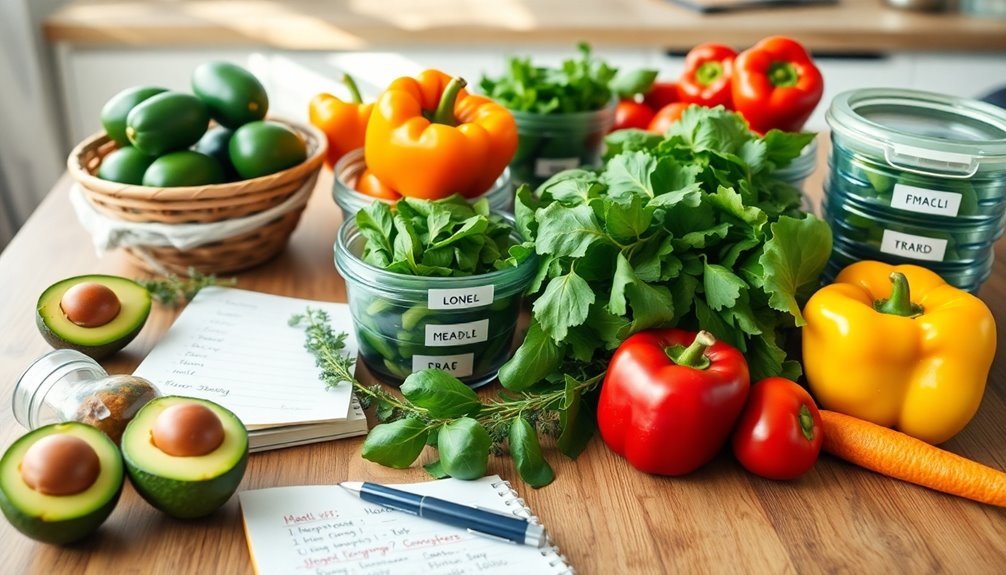
Creating a shopping list is an essential step in your meal prep journey that can streamline your cooking process and save you time and money. By taking the time to jot down everything you need, you'll avoid those last-minute trips to the store that can derail your budget planning. Start by reviewing the recipes you've chosen and identify the ingredients required for each dish. This not only guarantees you have everything on hand but also helps you resist the temptation of impulse buys.
As you compile your list, consider recipe variations. For instance, if you enjoy roasted vegetables, you might choose a variety of seasonal produce that can be swapped in and out based on availability. This flexibility keeps your meals exciting and can help you use what you already have in your pantry.
Grouping your ingredients by category—like produce, proteins, grains, and pantry staples—can make your shopping trip more efficient. You'll save time wandering the aisles and can keep track of your spending better.
Don't forget to check for any sales or discounts on items that fit your list. This is another way to enhance your budget planning and make your meal prep routine even more economical. Additionally, consider incorporating smoothies as meal replacements to add variety and nutrition to your meals. Remember, a well-planned shopping list not only prepares you for a successful week of meals but also fosters a sense of belonging in your cooking community. You're not just cooking for yourself; you're nourishing yourself and those you care about.
Invest in Meal Prep Tools
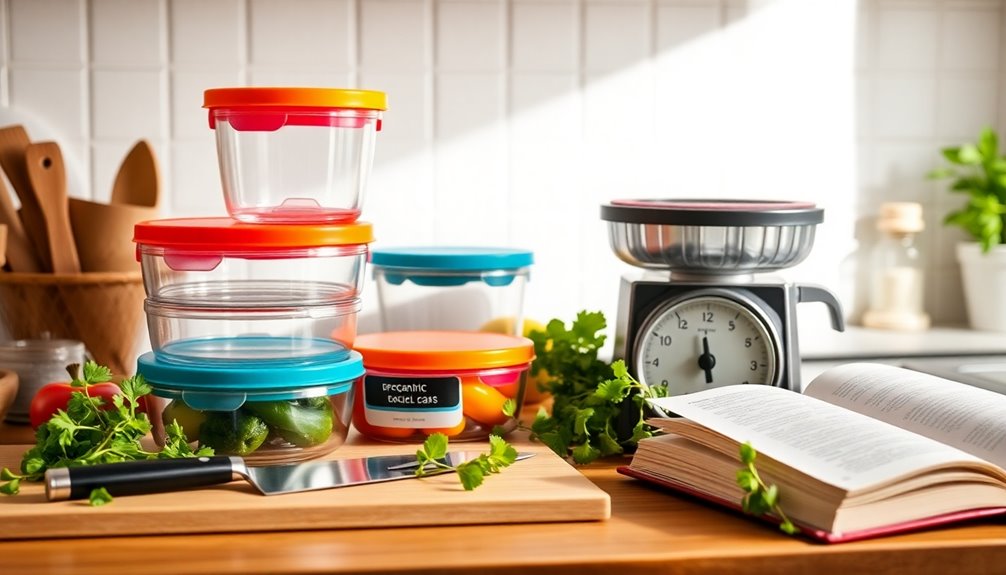
Investing in the correct meal prep tools can significantly enhance your cooking experience and streamline the process. When you equip your kitchen with essential equipment, you'll not only improve your time management but also make the entire meal prep routine more enjoyable and efficient. Here's a quick guide to the must-have tools that can elevate your meal prep game:
| Essential Equipment | Purpose | Benefits |
|---|---|---|
| Food Processor | Chopping, slicing, and mixing | Saves time on prep work |
| Measuring Cups/Spoons | Accurate ingredient measurements | Ensures uniform results |
| Glass Containers | Storing meals safely | Keeps food fresh and organized |
| Sharp Knives | Cutting ingredients easily | Makes prep faster and safer |
| Slow Cooker | Cooking meals while you're busy | Saves time and enhances flavor |
By investing in these tools, you'll find that you can prepare meals more quickly, leaving you with extra time to enjoy life outside the kitchen. For example, a food processor can reduce your chopping time in half, allowing you to focus on the enjoyable aspects of cooking. Additionally, having quality glass containers helps with portion control and makes it easy to grab meals on the go. Incorporating mini bands into your routine can also support your fitness goals while meal prepping.
Ultimately, the proper meal prep tools not only simplify your routine but also foster a sense of belonging in your meal prep community. You'll connect with others who prioritize healthy eating and share tips, recipes, and experiences, making your meal prep journey all the more rewarding.
Designate a Prep Day
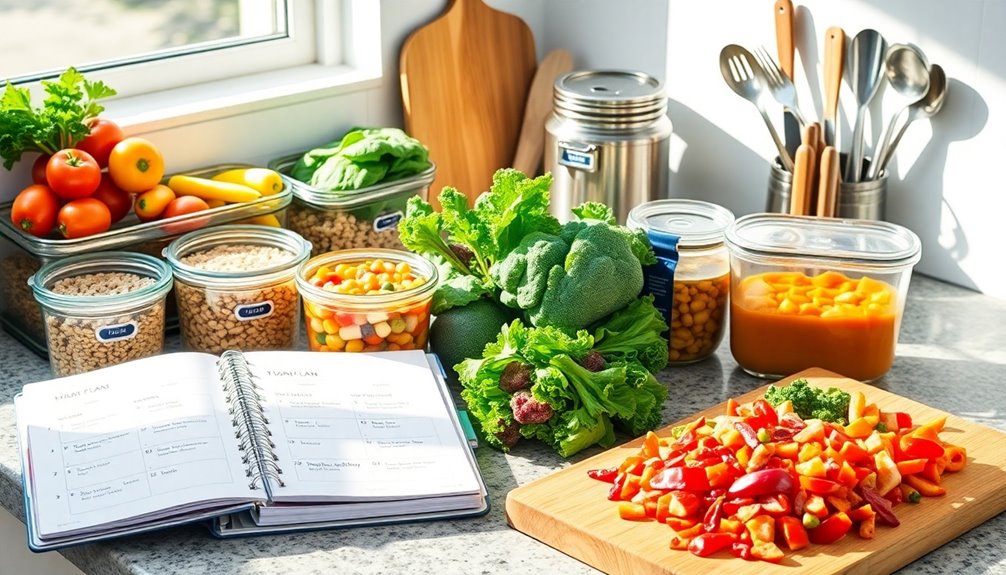
A designated prep day can transform your meal prep routine into a streamlined and efficient process. By setting aside a specific day each week, you give yourself the gift of time management and the opportunity to establish a rhythm in your kitchen. This consistency not only simplifies your week but also reduces the stress of last-minute cooking.
Choose a day that fits your schedule—perhaps Sunday or Wednesday. Make it a ritual. Gather your favorite recipes, and plan out your meals. This structured approach enhances kitchen organization, as you'll know exactly what needs to be done and when. Having a clear plan helps you avoid the chaos of scrambling for ingredients mid-cook.
On your prep day, dedicate a few hours to chopping, marinating, and cooking. Batch-cook grains, roast vegetables, and portion proteins. Not only will this save you time during busy weekdays, but it also promotes mindful eating, as you're more likely to choose prepped meals over unhealthy convenience options. Additionally, consider exploring custom keto diet plans to diversify your meal options and align with your dietary goals.
Invite family or friends to join you; it can be a fun, social experience that builds a sense of community around healthy eating. You'll find that sharing the workload and ideas fosters creativity and can lead to discovering new recipes together.
Organize Your Ingredients
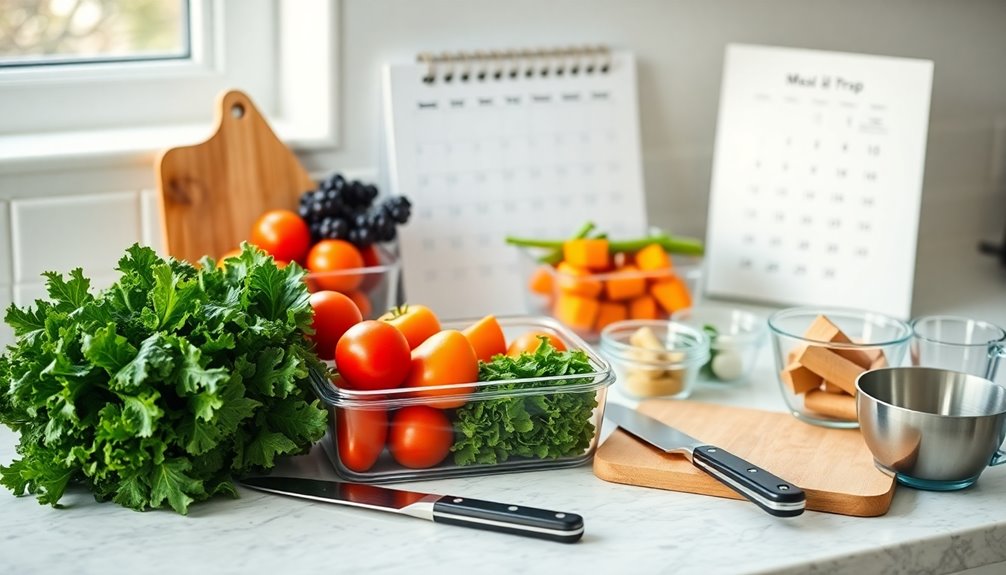
Organized ingredients make meal prep easier and more efficient, allowing you to focus on cooking rather than searching for items. When you streamline your process, you also enhance your time management skills, making it simpler to whip up delicious meals without added stress. Start by evaluating your storage solutions to confirm they fit your needs and kitchen space.
Here are some practical tips for organizing your ingredients:
- Group Similar Items: Keep spices, oils, grains, and proteins in designated areas. This reduces time spent rummaging through your pantry.
- Use Clear Containers: Transparent storage helps you quickly identify what's inside, so you'll know when to restock or use something before it expires.
- Label Everything: Clear labels on containers make it easy to find what you need, encouraging everyone in your household to assist with meal prep.
- Prioritize Accessibility: Place frequently used ingredients at eye level and less common items on higher shelves, ensuring effortless access during your cooking sessions. Additionally, using organized ingredients can support your journey towards rapid fat loss as part of a comprehensive meal prep strategy.
Store Meals Properly
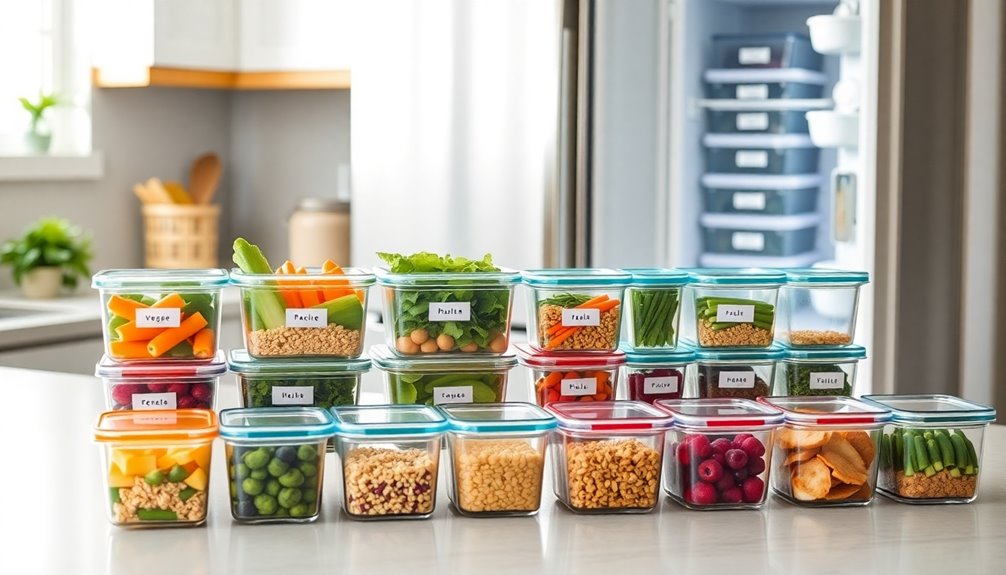
Once you've prepared your meals, storing them properly is crucial to maintaining their freshness and flavor. To safeguard your meals stay delicious and safe to eat, follow some simple food safety guidelines. Use airtight containers to prevent moisture and air from spoiling your food. Glass containers are often the best choice as they don't retain odors or stain.
Here's a quick reference table to help you with proper storage times:
| Food Type | Recommended Storage Time |
|---|---|
| Cooked Proteins | 3-4 days |
| Cooked Grains | 4-6 days |
| Fresh Vegetables | 3-7 days (depends on type) |
When you store your meals, label each container with the date you prepared it, so you can easily keep track of how long it's been in the fridge. Make certain your refrigerator is set to 40°F (4°C) or below, as this helps slow bacterial growth. For longer storage, consider freezing your meals. Most cooked dishes can last up to three months in the freezer if stored properly. Remember to experience the satisfaction of hand sharpening your knives regularly to ensure they remain effective for meal prep.
Review and Adjust Regularly
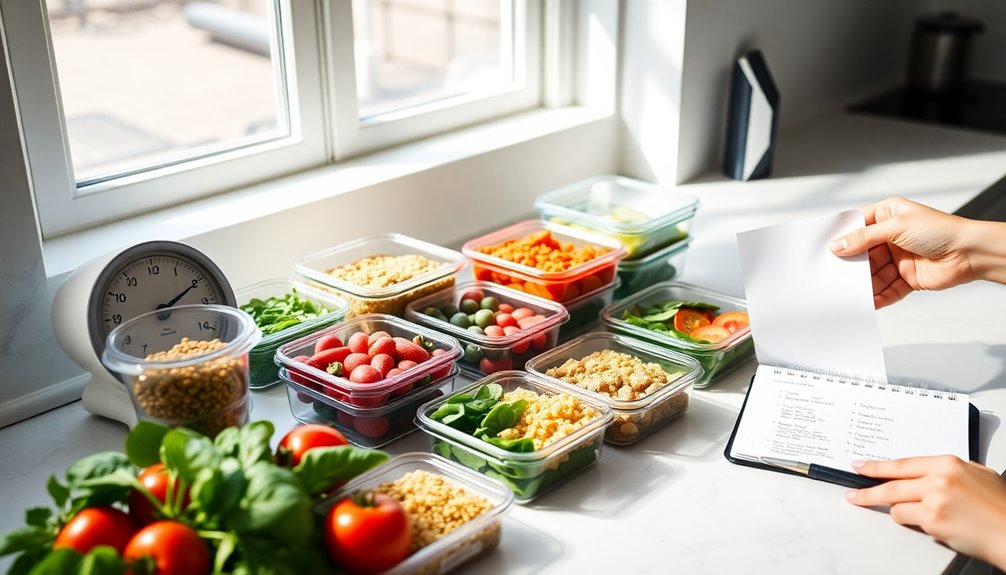
Regularly reviewing and adjusting your meal prep routine is essential for maximizing efficiency and ensuring you meet your nutritional goals. By taking the time to evaluate your progress, you can identify what's working and what needs a little tweaking. This practice not only helps you stay on track but also fosters a sense of belonging in your journey toward healthier eating.
Here are some practical steps to guide your review process:
- Assess Your Meals: Look at your meals from the past few weeks. Did you enjoy them? Were they satisfying? Make note of favorites and any that fell flat.
- Check Nutritional Goals: Are you reaching your dietary targets? If not, consider tweaking your plans to incorporate more variety or balance in your meals.
- Time Management: Reflect on the time you spend prepping. Is it taking longer than expected? If so, think about simplifying recipes or prepping in bulk.
- Solicit Feedback: If you're meal prepping for family or friends, ask for their input. Their preferences can help you create meals that everyone looks forward to.
Additionally, consider how your meal choices can impact your overall health, as improper nutrition may lead to chronic health issues that can complicate recovery and daily activities.
Frequently Asked Questions
How Do I Stay Motivated to Meal Prep Consistently?
Staying motivated to meal prep consistently starts with setting goals that excite you. Break your tasks into manageable steps and track your progress for accountability. Keep things fresh by incorporating variety and creativity into your meals; try new recipes or themes each week. Connect with friends or online communities who share your passion for meal prepping. This sense of belonging can boost your motivation and keep you engaged in your journey.
Can I Meal Prep for Special Diets or Restrictions?
You might think meal prepping's too hard with special diets, but it's totally doable! Whether you're into vegan meal prep, need gluten-free options, or are focused on low carb meal prep, you can customize your meals easily.
Allergen-free meal prep is also straightforward, allowing you to avoid specific ingredients while still enjoying delicious dishes. Embrace your dietary needs by planning ahead, and you'll find meal prepping becomes a rewarding part of your routine!
What Are Some Tips for Prepping Meals for Kids?
When prepping meals for kids, focus on lunchbox options that are both nutritious and appealing. Try incorporating kid-friendly recipes like mini quesadillas, veggie sticks with hummus, or fruit skewers. Involve your kids in the process by letting them pick their favorite ingredients, which can increase their excitement about meals.
Also, consider batch cooking to save time, ensuring you always have healthy options on hand for busy school days.
How Can I Handle Food Spoilage During Meal Prep?
So, you've prepped a week's worth of gourmet meals, only to find them swimming in a pool of regret—aka spoiled food? Don't fret! Master food storage by using airtight containers, and keep an inventory management system to track your meals. Label each dish with dates, so you're not playing a guessing game.
Rotate your meals, and enjoy fresh, delicious food without the drama of waste, ensuring you always belong to the clean plate club!
What Should I Do if I Run Out of Meal Prep Ideas?
If you're running out of meal prep ideas, look up recipe websites or browse through cookbooks for inspiration. You'll find countless options that can refresh your menu.
Don't hesitate to try food delivery services or meal kits, too; they often introduce new flavors and concepts.
Engaging with online communities can also spark creativity, as you share and discover recipes together. You'll feel more connected and inspired in your meal prep journey.
Conclusion
Building a consistent meal prep routine might seem overwhelming at first, but the rewards are worth it. Imagine opening your fridge to perfectly labeled, ready-to-eat meals that save you time and stress during busy weekdays. By taking small steps—like setting a prep day and organizing your ingredients—you'll find it easier to stick with it. Don't let the fear of routine hold you back; embrace the convenience of meal prep and enjoy healthier, homemade meals every day.

